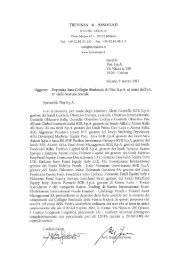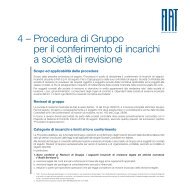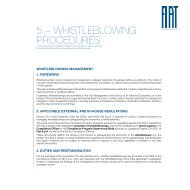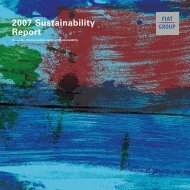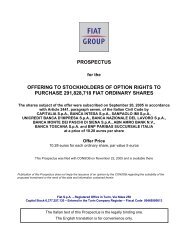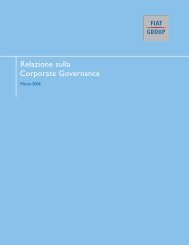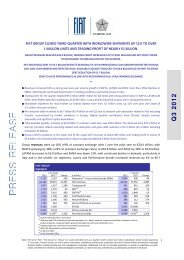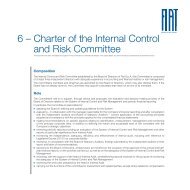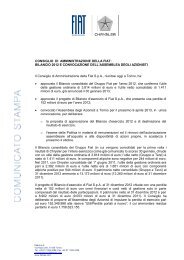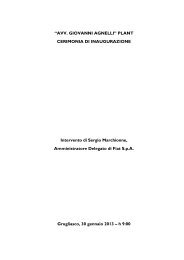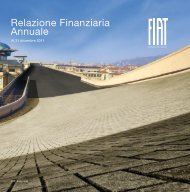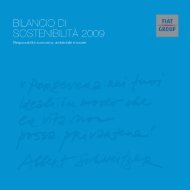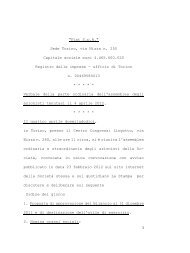annual report - FIAT SpA
annual report - FIAT SpA
annual report - FIAT SpA
Create successful ePaper yourself
Turn your PDF publications into a flip-book with our unique Google optimized e-Paper software.
Assets and liabilities held for sale and Discontinued Operations<br />
Non-current assets and disposal groups are classified as held for sale if their carrying amounts will be recovered<br />
principally through a sale transaction rather than through continuing use. This condition is regarded as met only when<br />
the sale is highly probable and the non-current asset (or disposal group) is available for immediate sale in its present<br />
condition. When the Group is committed to a sale plan involving loss of control of a subsidiary, all of the assets and<br />
liabilities of that subsidiary are classified as held for sale when the criteria described above are met, regardless of<br />
whether the Group will retain a non-controlling interest in its former subsidiary after the sale.<br />
Non-current assets and disposal groups classified as held for sale are measured at the lower of their carrying<br />
amounts and fair value less costs to sell.<br />
Employee benefits<br />
Pension plans<br />
Employees of the Group participate in several defined benefit and/or defined contribution pension plans in accordance<br />
with local conditions and practices in the countries in which the Group operates.<br />
The Group's obligation to fund defined benefit pension plans and the <strong>annual</strong> cost recognised in the income statement<br />
are determined on an actuarial basis using the projected unit credit method. The portion of net cumulative actuarial<br />
gains and losses which exceeds the greater of 10% of the present value of the defined benefit obligation and 10% of<br />
the fair value of plan assets at the end of the previous year is amortised over the average remaining service lives of<br />
the employees (the “corridor approach”). In the context of IFRS First-time Adoption, the Group elected to recognise all<br />
cumulative actuarial gains and losses that existed at 1 January 2004, even though it had decided to use the corridor<br />
approach for subsequent actuarial gains and losses.<br />
The post-employment benefit obligation recognised in the statement of financial position represents the present value<br />
of the defined benefit obligation as adjusted for unrecognised actuarial gains and losses, arising from the application<br />
of the corridor method and unrecognised past service cost, reduced by the fair value of plan assets. Any net asset<br />
resulting from this calculation is recognised at the lower of its amount and the total of any cumulative unrecognised<br />
net actuarial losses and past service cost, and the present value of any economic benefits available in the form of<br />
refunds from the plan or reductions in future contributions to the plan.<br />
If changes are made to a plan that alter the benefits due for past service or if a new plan is introduced regarding past<br />
service then past service costs are recognised in the income statement on a straight-line basis over the average<br />
period remaining until the benefits become vested. If a change is made to a plan that significantly reduces the number<br />
of employees who are members of the plan or that alters the conditions of the plan such that employees will no longer<br />
be entitled to the same benefits for a significant part of their future service, or if such benefits will be reduced, the<br />
profit or loss arising from such changes is immediately recognised in the income statement.<br />
All other costs and income arising from the measurement of pension plan provisions are allocated to costs by function<br />
in the income statement, except for interest cost on unfunded defined benefit plans which is <strong>report</strong>ed as part of<br />
Financial expenses.<br />
Costs arising from defined contribution plans are recognised as an expense in the income statement as incurred.<br />
Post-employment plans other than pensions<br />
The Group provides certain post-employment defined benefits, mainly health care plans. The method of accounting<br />
and the frequency of valuations are similar to those used for defined benefit pension plans.<br />
The scheme underlying the Employee leaving entitlements in Italy of the Italian Group companies (the TFR) was<br />
classified as a defined benefit plan until 31 December 2006. The legislation regarding this scheme and leading to this<br />
classification was amended by Law no. 296 of 27 December 2006 (the “2007 Finance Law”) and subsequent decrees<br />
and regulations issued in the first part of 2007. In view of these changes, and with specific reference to those<br />
regarding companies with at least 50 employees, this scheme only continues to be classified as a defined benefit plan<br />
in the consolidated financial statements for those benefits accruing up to 31 December 2006 (and not yet settled by<br />
the balance sheet date), while after that date the scheme is classified as a defined contribution plan.<br />
Equity compensation plans<br />
The Group provides additional benefits to certain members of senior management and employees through equity<br />
compensation plans (stock option plans and stock grants). In accordance with IFRS 2 – Share-based Payment, these<br />
plans represent a component of recipient remuneration. The compensation expense, corresponding to the fair value of<br />
the instruments at the grant date, is recognised in the income statement on a straight-line basis over the period from<br />
the grant date to the vesting date, with the offsetting credit recognised directly in equity. Any subsequent changes to<br />
Fiat Group Consolidated Financial Statements at 31 December 2010 119



